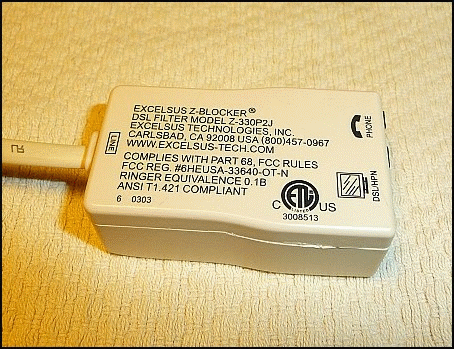|
K6JRF's Page formerly W6FZC DSL Operation with DirecTV Sat Receiver Photos by K6JRF |
(Update: Aug 5, 2015)
|
DSL Operation with DirecTV Sat Receiver |
Z-Block Filter Stock Analysis
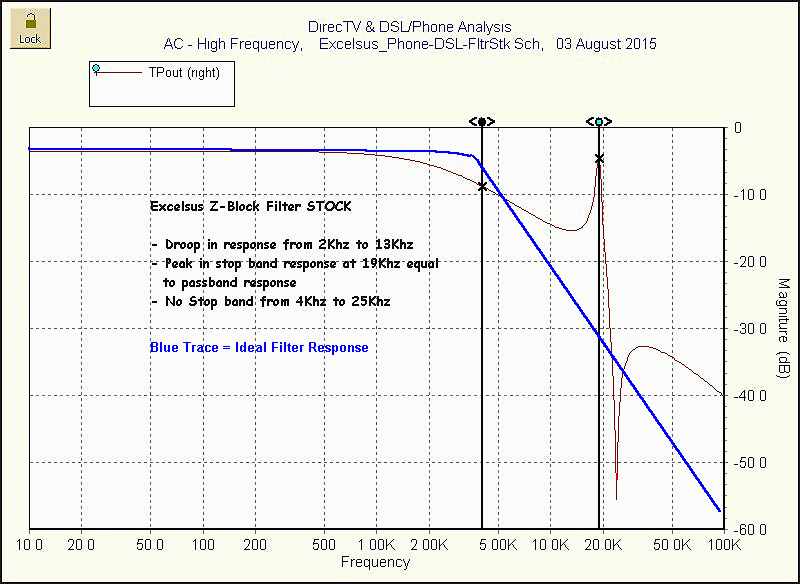 Using 5Spice, the Z-Blocker filter was analyzed to see how it shapes the POTS frequency spectrum;
a LPF with 4Khz as the corner frequency. What the analysis showed is precisely why that filter didn't work.
Using 5Spice, the Z-Blocker filter was analyzed to see how it shapes the POTS frequency spectrum;
a LPF with 4Khz as the corner frequency. What the analysis showed is precisely why that filter didn't work. The "stock" filter analysis shows it doesn't just cover the POTS filter band but extends to 25Khz before attenuating signals. At 18Khz, there's a peak of 0dB. Not what you expect. Note that at 100Khz, the filter stop band attenuation is only -40db. Compared to the "ideal" filter response (in BLUE), the spurious response between 5Khz and 30Khz shows that the circuit values are no where close to optimum! Each filter element, L1 - L4 and C1 - C3 were de-soldered from the PCB and measured as shown in the schematic. The value of each element including inductor's series resistance: L1 = 4.95mH - Rs = 4.45 ohms L2 = 4.92mH - Rs = 4.40 ohms L3 = 4.47mH - Rs = 3.80 ohms L4 = 4.46mH - Rs = 4.78 ohms * The series resistance wasn't included in the ckt modeling b/c the values didn't effect the filter's response. Now, having all circuit elements quantified, the 5Spice schematic was re-drawn into the program's schematic capture and then run to analyze it for improved circuit response. |
Z-Block Filter Stock -Reverse- Analysis
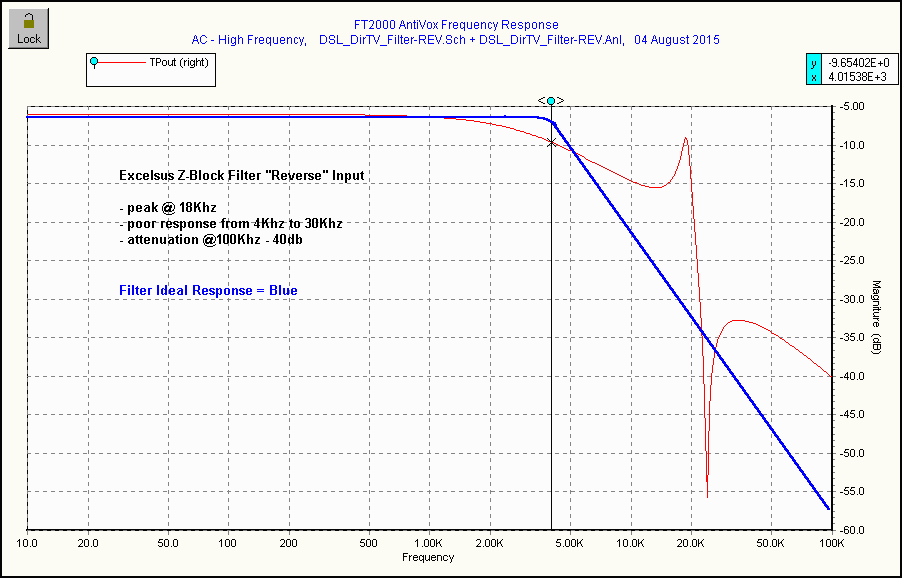 Perhaps the filter performs better when the PHONE input is employed. The schematic shows the circuit layout where the DTV H24 rcvr is connected
via the PHONE input.
Perhaps the filter performs better when the PHONE input is employed. The schematic shows the circuit layout where the DTV H24 rcvr is connected
via the PHONE input.Using 5Spice, this Z-Blocker configuration was analyzed to see how it shapes the POTS frequency spectrum. This analysis showed basically the same response as the previous analysis. The "REVERSE" filter analysis shows it doesn't just cover the POTS filter band but extends to 30Khz before attenuating signals. At 18Khz, there's a peak of apx 0dB. Note that at 100Khz, the filter stop band attenuation is only -40db. Compared to the "ideal" filter response (in BLUE), the spurious response between 5Khz and 30Khz shows that the circuit values are no where close to optimum! |
|
Z-Block Filter Modified Analysis After a preliminary analysis, it was apparent that the original C1, C2 and C3 values, 0.01uf were not optimum. A little more showed that 0.2uf ceramic caps were the correct values. Parts (0.02uf, 100V) were purchased from Mouser Electronics here It also become obvious, that swapping the inductors would materially improve the filter and the filter should PLUG INTO THE RCVR and not into the phone line! The inductors, L1 - L4 were swapped position wise as shown in the picture below. 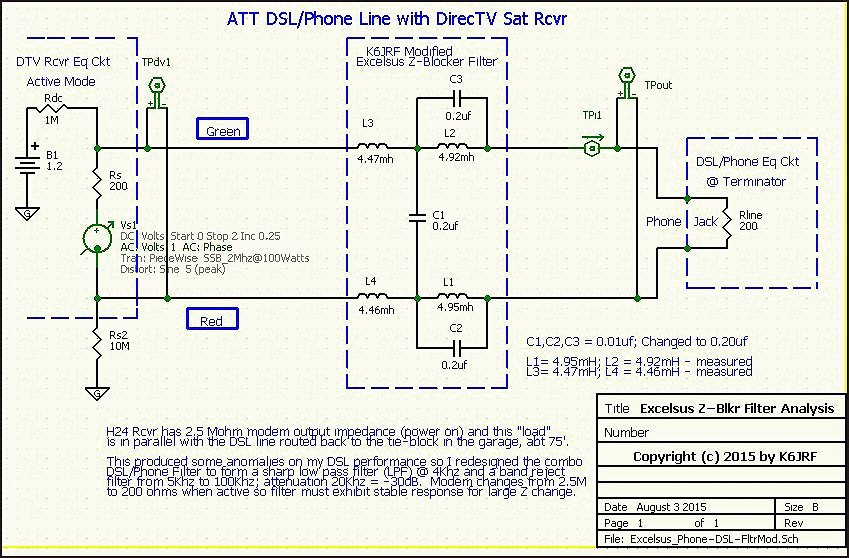
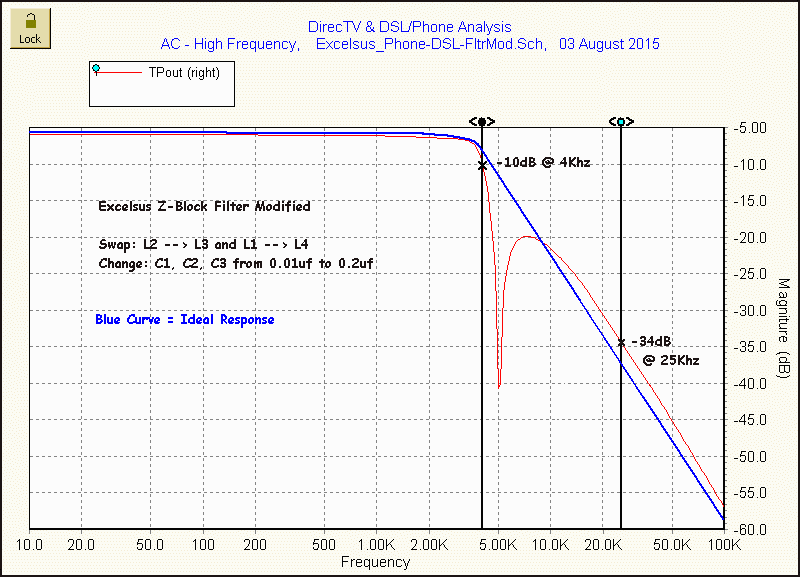 The H24 modem is "on-hook" until it "phones-home" when the modem's output impedance is apx 200 ohms. The analysis is shows the response when
the rcvr is active. The resultant performance curve DOES reflect a POTS response of 0 to 4Khz and approximates the ideal response
chart (in BLUE). Also note -34dB attenuation @ 25Khz, the start of the "upstream" band.
The H24 modem is "on-hook" until it "phones-home" when the modem's output impedance is apx 200 ohms. The analysis is shows the response when
the rcvr is active. The resultant performance curve DOES reflect a POTS response of 0 to 4Khz and approximates the ideal response
chart (in BLUE). Also note -34dB attenuation @ 25Khz, the start of the "upstream" band. |
Summary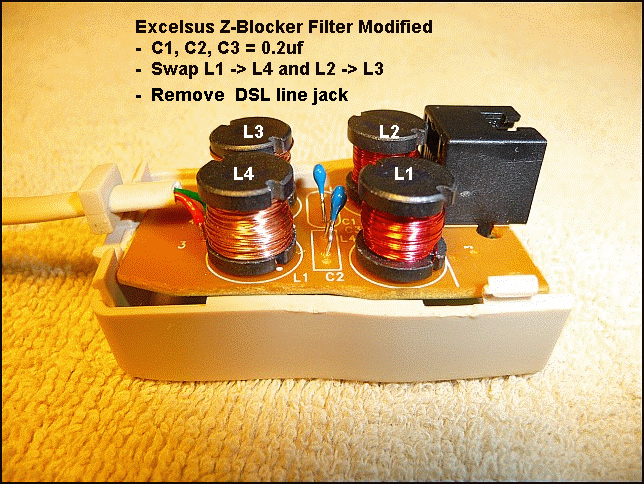
 The modified Z-Block Filter uses the "pig-tail" to plug into the sat rcvr as the picture shows. The PHONE jack takes an extension to plug
into the normal wall phone jack. This is not the normal way it is used!
The modified Z-Block Filter uses the "pig-tail" to plug into the sat rcvr as the picture shows. The PHONE jack takes an extension to plug
into the normal wall phone jack. This is not the normal way it is used!The stock Z-Block Filter design uses the guard band (4 - 25Khz) but IMO, it is best to NOT to design the POTS filter to use that band. Using it does NOT allow the ultimate attenuation in the "upstream" band to be achieved. Please note that at the TERMINATOR, there is a ADSL + POTS filter installed to isolate the DSL signals from this special phone line to the DTV rcvr. Over the last week, DSL performance has been superb, so the modified Z-Blocker filter is the best solution solving both the impedance loss and DSL line isolation at the DTV rcvr. |
|
Send me |
 All DTV rcvrs can be tied into the phone line so that PPV (movies, special events) can be automatically ordered via the remote control. The
phone line serves to provide DTV with the rcvr's location as well record the purchase on the "smart-card". Later, during the month, the rcvr
"phones home" upon command to dump the PPV purchases and reset the card.
All DTV rcvrs can be tied into the phone line so that PPV (movies, special events) can be automatically ordered via the remote control. The
phone line serves to provide DTV with the rcvr's location as well record the purchase on the "smart-card". Later, during the month, the rcvr
"phones home" upon command to dump the PPV purchases and reset the card.  POTS and ADSL service occupy different frequency spectrums. POTS exists in the 0-4 kHz region and ADSL service is present from 26kHz
to approximately 1.1MHz.
POTS and ADSL service occupy different frequency spectrums. POTS exists in the 0-4 kHz region and ADSL service is present from 26kHz
to approximately 1.1MHz. The newly upgraded H24 rcvr replaced the older H23-600 rcvr. With the phone line connected to the H24, my DSL performance
suffered; low speed, lost packets, line stalls so I investigated to find what differences there might be.
The newly upgraded H24 rcvr replaced the older H23-600 rcvr. With the phone line connected to the H24, my DSL performance
suffered; low speed, lost packets, line stalls so I investigated to find what differences there might be.